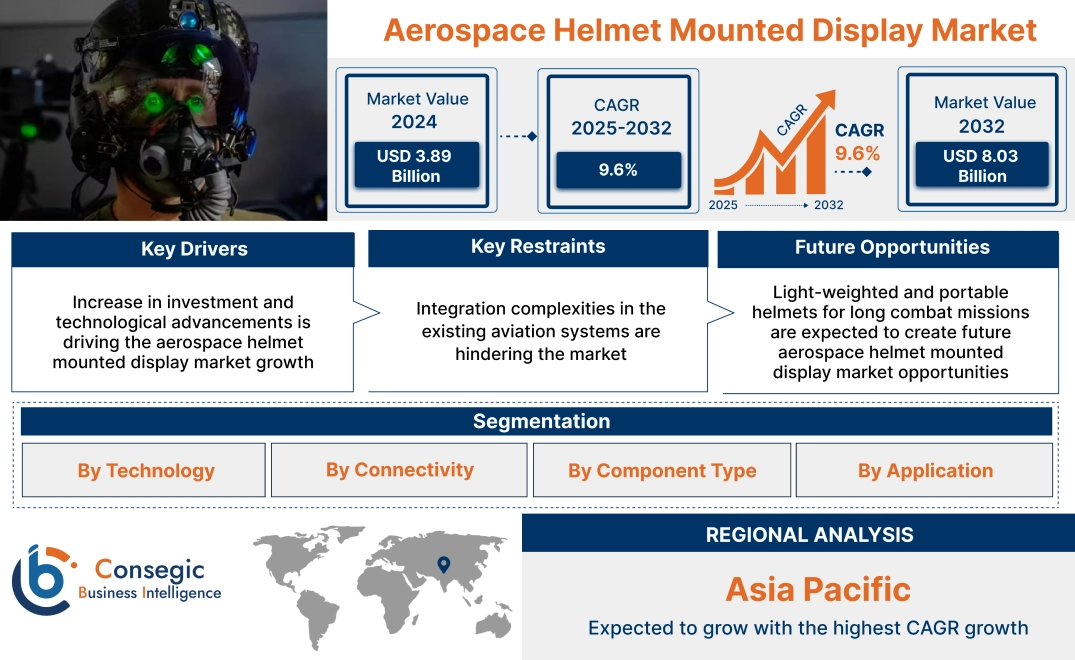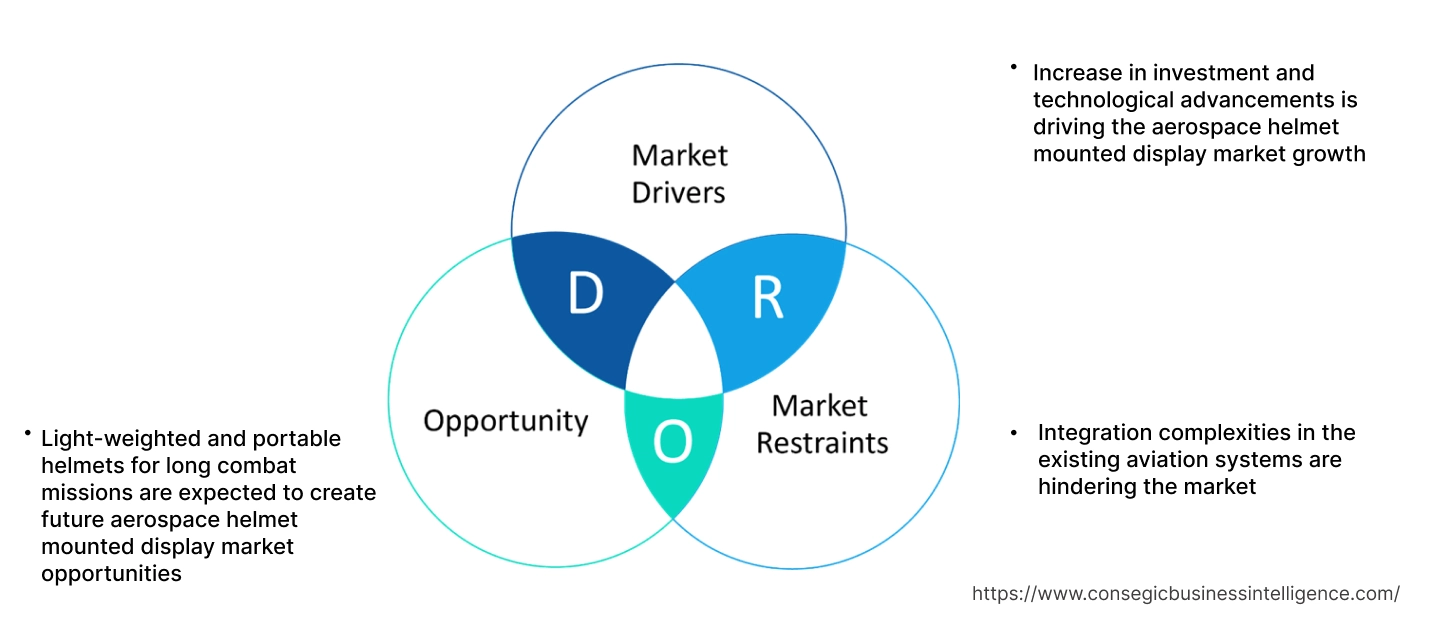- Summary
- Table Of Content
- Methodology
Aerospace Helmet Mounted Display Market Size:
Aerospace Helmet Mounted Display Market Size is estimated to reach over USD 8.03 Billion by 2032 from a value of USD 3.89 Billion in 2024 and is projected to grow by USD 4.23 Billion in 2025, growing at a CAGR of 9.6% from 2025 to 2032.
Aerospace Helmet Mounted Display Market Scope & Overview:
An aerospace helmet mounted display is a headworn display device that has a small display optic in front of one or both eyes and uses displays and optics for image projection. The purpose of helmet mounted display is to overlay virtual information over the real world, displaying flight parameters and sensor information on a translucent visor for advanced situational awareness. Furthermore, helmet mounted display allows pilots to align sensors and weapons with their line of sight ensuring precise targeting while continually monitoring critical flight information.
Key Drivers:
Increase in investment and technological advancements is driving the aerospace helmet mounted display market growth
The increasing demand for helmet mounted displays is due to the incorporation of advanced technologies such as the integration of all-digital night vision systems and daylight readable color displays. Moreover, the data is directly displayed on the pilot’s helmet visor, providing them with critical information. Additionally, it also provides situational awareness, optional 3D audio, and battle-proven target-tracking technology, incorporated in a single helmet mounted display system. Further, the continuous investments from European nations striving to enhance aviation capabilities are driving the market growth.
- For instance, in September 2023, the Eurofighter consortium (Germany, Italy, Spain, and the UK), awarded BAE Systems a USD 138 million contract for StrikeR II Helmet Mounted-Display development.
Thus, the increasing investments by the key players in the aviation sector are driving the aerospace helmet mounted display market size.
Key Restraints:
Integration complexities in the existing aviation systems are hindering the market
The integration of helmet mounted displays with existing aircraft systems, including avionics, targeting systems, and communication networks demands significant customization and advancement. Also, these processes are technically complex and require initial high investment, restraining market growth. Additionally, compatibility issues hinder its adoption and necessitate additional investments, impacting overall implementation efficiency.
Thus, as per the analysis, rising integration complexities in helmet mounted displays are impeding the aerospace helmet mounted display market growth.
Future Opportunities :
Light-weighted and portable helmets for long combat missions are expected to create future aerospace helmet mounted display market opportunities
A lightweight HMD is required for long missions to enhance the operators’ ability to respond quickly as with heavier HMDs there is an increased risk of injury during rapid maneuvers. Lighter design minimizes this risk ensures safety and improves operational efficiency. Moreover, lightweight helmets provide stability, reduce the risk of physical strain, and also allow users to move without any restriction while maintaining situational awareness.
- For instance, India’s premier defense research, the Defence Research and Development Organisation (DRDO), has developed a lightweight integrated helmet to be used by Indian Air Force pilots.
Hence, based on the analysis the light-weight helmet mounted display systems are expected to create aerospace helmet mounted display market opportunities for ensuring comfort and efficient performance.
Aerospace Helmet Mounted Display Market Segmental Analysis :
By Technology Type:
Based on the technology type, the market is segmented into augmented reality (AR), and virtual reality (VR).
Trends in the Technology Type:
- VR in aviation revolutionizes the aviation sector by training pilots, inspecting aircraft, and improving operational efficiency.
- Augmented reality provides real-time contextual information offering many solutions for overcoming technical challenges prevalent in the aerospace maintenance, repair, and overhaul industry with advanced remote tech support solutions.
The augmented reality segment accounted for the largest revenue share.
- AR technology provides an intuitive way to maintain, repair, and overhaul (MRO) technicians to explore the various components of any aircraft.
- Additionally, AR technology merges physical, and digital worlds through interactive, 3D holographic representations.
- Furthermore, by using augmented reality technology, pilots can access a dynamic and immersive training environment equipping them with the necessary skills.
- For instance, in October 2024, CAE developed CAE’s Apple Vision Pro app, an augmented reality system for Apple Vision Pro which helps pilots familiarize themselves with the flight deck, practice critical procedures, and develop muscle memory for key functions.
- Thus, as per the analysis the rising advancements and collaboration with augmented reality technology are driving the aerospace helmet mounted display market size.
The virtual reality segment is expected to register the highest CAGR over the forecast period.
- Virtual reality offers pilots with HUD/HGS operations in a realistic, 3D virtual reality cockpit environment providing superior image quality and performance.
- It also helps with visualization of navigating systems, air-traffic control, weather, terrain, and airspace information.
- Moreover, using virtual reality technology improves the manufacturing process, facilitates personnel training, and ensures better aircraft maintenance.
- For instance, Collins Aerospace launched SimEye SX50T II which is a high-performance helmet-mounted display. Its features include high brightness, SXGA 1,280-by-1,024 resolution for high-quality visuals, monochrome green displays, and projection onto translucent optics display to offer unparalleled performance.
- Thus, the integration of virtual reality technology into helmet mounted displays is driving the aerospace helmet mounted display market trends for offering advanced technologies.
By Connectivity Type:
Based on the connectivity type, the market is segmented into wired and wireless.
Trends in the Connectivity Type:
- For long flight missions where comfort directly impacts the performance and focus, these wireless helmet mounted displays are required.
- Wired helmet mounted displays are cost-effective compared to their wireless counterparts, an ideal option for budget constrained defense and commercial aviation sectors.
The wireless helmet mounted display segment dominated the target market for the largest revenue share in 2024 and is also projected to witness the fastest CAGR in the forecast period.
- The wireless helmet mounted display eliminates the need for cables, which in the aviation industry is highly beneficial.
- Moreover, there is no physical connection required, which significantly reduces downtime and simplifies logistics.
- Furthermore, wireless helmet mounted display systems are less bulky and lighter in weight.
- For instance, Elbit Systems’ see-through aerospace helmet-mounted display, provides full situational awareness, improves operational efficiency, and is cost-effective, lightweight, and compact.
- Thus, the wireless helmet mounted display is trending due to its lightweight feature and advanced capabilities.
By Component Type:
Based on the component type the market is segmented into Display, Sensor, Controller, Lens, Processor and Memory, Cameras, and Cases and Connectors.
Trends in component type:
- The modern generation of helmet mounted display systems offers full-colour operation using our novel optics and coatings.
- The versatility of the sensors such as their integration with AR technology for night military operations and targeting is increasing the aerospace helmet mounted display market trends.
The display segment accounted for the largest revenue share in the year 2024.
- An HMD’s resolution outlines the smallest size object (target) that can be displayed, producing sharp and detailed visuals.
- Moreover, the capability of display technology to provide a 360-degree field of view, traffic callouts, and flight parameters is ideal for night missions.
- For instance, in 2022, Honeywell launched its 360 display system which provides unparalleled situational awareness, and a 360-degree field of view by integrating multiple databases including terrain, traffic, and weather with high-resolution, ultra-low-latency view.
- Thus, based on the above analysis there is an increasing need for advanced display technology in the aerospace helmet mounted display market.
The sensors segment is anticipated to register the fastest CAGR during the forecast period.
- Sensors are widely utilized to deploy high-performance tracking, navigation, visualization, and stabilization applications.
- Sensors integrated into helmet mounted display systems allow for real-time data collection, also the head-tracking sensors are improving the accuracy and reliability of HMD systems leading to increased demand.
- For instance, in November 2023, HENSOLDT and BAE Systems developed a Striker II helmet-mounted display for the Royal Air Force’s Typhoon fleet. HENSOLDT’s advanced optic sensors are used in the helmet, and also it developed the system’s inertial storage driver unit (ISDU), the electronic component that provides the helmet’s intelligence.
- According to the aerospace helmet mounted display market analysis, the increasing advancements in the sensors segment are driving the aerospace helmet mounted display market demand.
By Application:
Based on the application, the market is segmented into Commercial Aviation, Defense & Military, and Space.
Trends in the Application:
- The increasing integration of augmented reality and virtual reality into aerospace helmet mounted display for a more immersive experience to enhance situational awareness in adverse weather conditions.
- Modern helmet mounted display systems in defense are increasingly integrating night vision and infrared technologies to enhance operations in low light.
Defense & Military accounted for the largest revenue share of 45% in the year 2024.
- Growing adoption of helmet mounted display in advanced fighter jets for combat operations.
- In the defense and military industry, helmet-mounted displays provide mission-critical information to pilots of fast jets and rotary wing platforms.
- Moreover, the helmet-mounted displays for fighter pilots need to be as light as possible due to the high g-forces experienced by fighter aircraft.
- For instance, in September 2023, a joint venture between Collins Aerospace, and Elbit Systems was awarded a contract by the Naval Air Warfare Centre Aircraft Division for the development of an ultra-lightweight Zero-G Helmet Mounted Display System.
- Thus, based on the aerospace helmet mounted display market analysis, the advanced features helping pilots with situational awareness are driving the market growth.
The commercial aviation segment is anticipated to register the fastest CAGR during the forecast period.
- Increasing demand for enhanced safety and efficiency for both pilots and passengers is growing the adoption of helmet mounted displays in commercial aviation.
- Additionally, helmet mounted displays provide pilots with critical flight information, such as altitude, speed, navigation routes, and weather conditions directly in front of their eyes.
- For instance, the Elbit Systems TARGO-II helmet mounted display, is lightweight, with minimal installation. It provides highly effective solutions for commercial platforms and general aviation. Equipped with advanced color and video display capabilities, and virtual training display support.
- Thus, the adoption of helmet mounted displays in civilian and commercial aviation is expected to grow the aerospace helmet mounted display market.
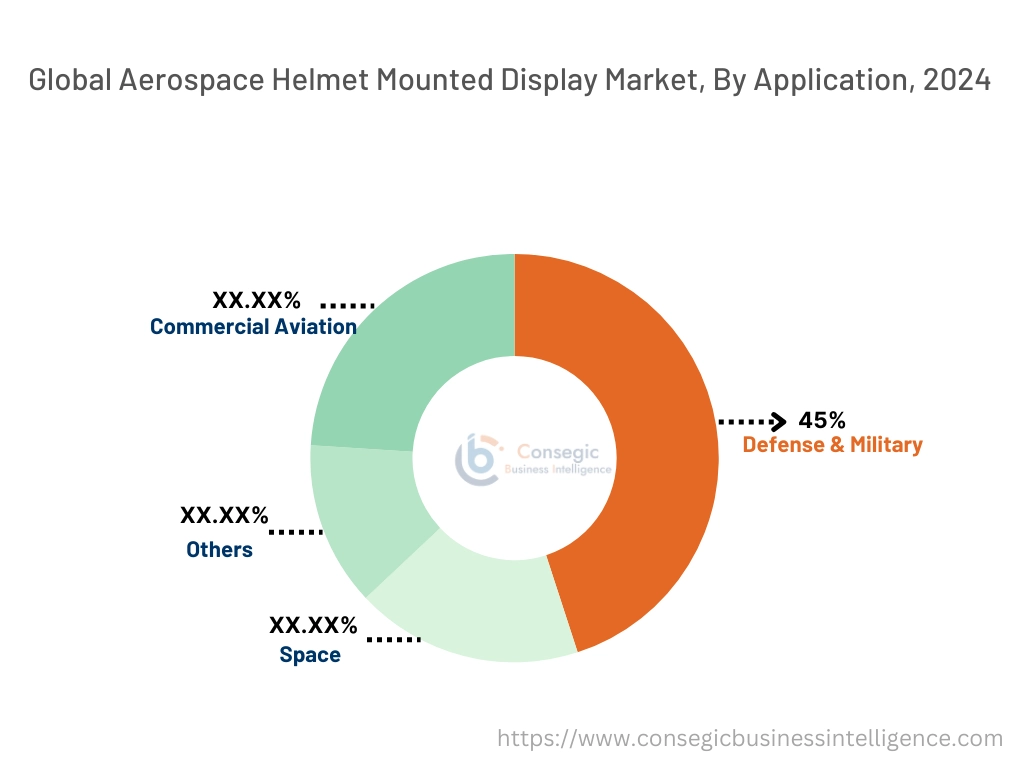
Regional Analysis:
The global aerospace helmet mounted display market has been classified by region into North America, Europe, Asia-Pacific, MEA, and Latin America.
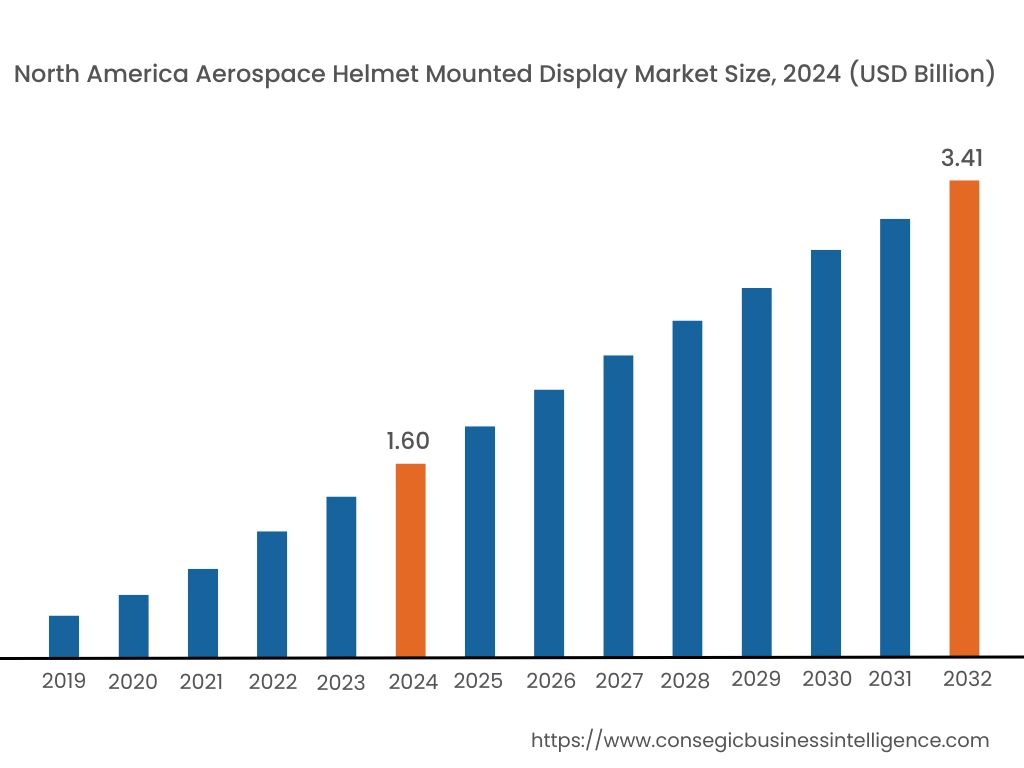
The North American region was valued at USD 1.60 Billion in 2024. Moreover, it is projected to grow by USD 1.74 Billion in 2025 and reach over USD 3.41 Billion by 2032. Out of these, the U.S. accounted for the largest revenue share of 74.3% in 2024.
North America holds the largest aerospace helmet mounted display market share in 2024. The region's dominance is due to the leading defense and aerospace companies and significant investments from the government for advanced military technologies. Additionally, due to the widespread adoption of helmet mounted displays in military and commercial aviation, extensive use of helmet mounted displays in fighter jets is driving the market growth. Increasing aerospace helmet mounted display market demand for pilot training in civil aviation further supports aerospace helmet mounted display market expansion.
- For instance, in September 2024, Kopin received USD 2 Million Follow-On Microdisplay Order in Support of Collins Aerospace’s F-35 Lightning II Helmet Mounted Display System, which uses Kopin’s microdisplay to provide pilots with extensive flight, tactical, and sensor information.
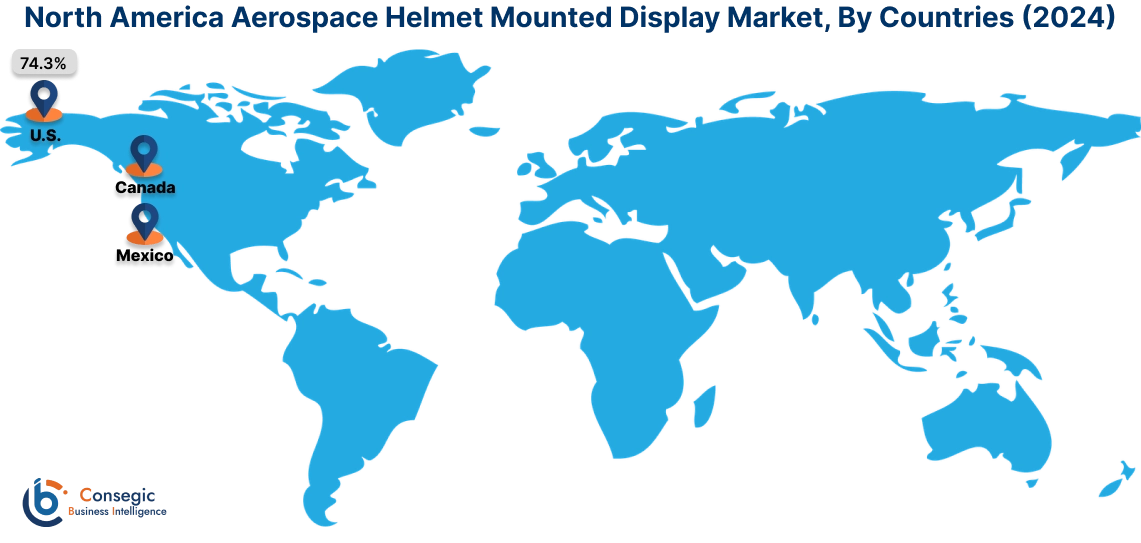
Asia Pacific region was valued at USD 1.02 billion in 2024. Moreover, it is projected to grow by USD 1.11 billion in 2025 and reach over USD 2.19 Billion by 2032.
Asian countries such as Japan, India, and China are majorly investing in military and defense leading to higher adoption of helmet-mounted displays for military applications. Additionally, rapid expansion in the civil and military aerospace sectors particularly in India and China is helping in aerospace helmet mounted display market expansion. Moreover, expanding civil aviation requires advanced pilot training programs for which helmet mounted displays are needed, the advancement in this sector is expected to continue during the forecast period. Asia-Pacific aerospace market key players hold a significant market segment, some of the key players in the market are Toray Industries Inc., Manufacturing Centre Co. Ltd, Mitsubishi Chemical Carbon Fiber and Composites Inc., Hexcel Corporation, and TATA Advanced Materials Limited. According to the analysis, the aerospace helmet mounted display market share of the Asia Pacific region is rising due to the increment in defense and aerospace investments.
- For instance, in January 2023, BAE Systems Australia secured a new contract with Lockheed Martin to activate an F-35 Asia-Pacific Regional Warehouse at its Williamtown aircraft sustainment operations in regional New South Wales
As per the analysis, European nations are investing heavily in aerospace technologies, and countries like the UK, France, and Germany, lead the market growth due to advanced defense programs and partnerships. The evolution in the MEA region is due to the rising adoption of augmented reality (AR) and virtual reality (VR) in the aviation sector. The demand for immersive experiences and interactive solutions is encouraging the use of helmet mounted displays for applications such as training simulations, maintenance and repair, quality control, and safety enhancement is making HMDs integral to these sectors' advancements. Growing commercial aviation increases the need for helmet mounted displays in countries like Brazil and Mexico.
Top Key Players and Market Share Insights:
The market is highly competitive with major players providing casino management solutions to the national and international markets. Key players are adopting several strategies in research and development (R&D), product innovation, and end-user launches to hold a strong position in the market. Key players in the aerospace helmet mounted display industry include-
- Collins Aerospace (US)
- Honeywell (US)
- Boeing (US)
- Elbit Systems (Israel)
- Toray Industries (Japan)
- Hexcel Corporation (US)
- Thales Group (France)
- GE Aerospace (US)
- Lockheed Martin (US)
- Hindustan Aeronautics (India)
- BAE Systems (US)
- BrahMos Systems (India)
Recent Industry Developments:
Partnerships & Collaborations:
- In October 2023, Thales collaborated with Korea’s Aerospace Industries (KAI) to equip FA-50 fighters for Poland with its highly successful Scorpion Helmet Mounted Display. It offers advanced features such as full-color symbology, zero-perceived latency, and a single display module for both day and night operations.
Aerospace Helmet Mounted Display Market Report Insights :
| Report Attributes | Report Details |
| Study Timeline | 2019-2032 |
| Market Size in 2032 | USD 8.03 Billion |
| CAGR (2025-2032) | 9.6% |
| By Technology |
|
| By Connectivity |
|
| By Component Type |
|
| By Application |
|
| By Region |
|
| Key Players |
|
| North America | U.S. Canada Mexico |
| Europe | U.K. Germany France Spain Italy Russia Benelux Rest of Europe |
| APAC | China South Korea Japan India Australia ASEAN Rest of Asia-Pacific |
| Middle East and Africa | GCC Turkey South Africa Rest of MEA |
| LATAM | Brazil Argentina Chile Rest of LATAM |
| Report Coverage |
|
Key Questions Answered in the Report
How big is the aerospace helmet mounted display market? +
The Aerospace Helmet Mounted Display Market Size is estimated to reach over USD 8.03 Billion by 2032 from a value of USD 3.89 Billion in 2024 and is projected to grow by USD 4.23 Billion in 2025, growing at a CAGR of 9.6% from 2025 to 2032.
What specific segmentation details are covered in the aerospace helmet mounted display report? +
The aerospace helmet mounted display report includes specific segmentation details for technology, connectivity, component type, application, and regions.
Which is the fastest segment anticipated to impact the market growth? +
In the aerospace helmet mounted display market, VR technology is the fastest-growing segment during the forecast period.
Who are the major players in the aerospace helmet mounted display market? +
The key participants in the aerospace helmet mounted display market are Collins Aerospace (US), Thales Group (France), GE Aerospace (US), Lockheed Martin (US), Hindustan Aeronautics (India), BAE Systems (US), BrahMos Systems (India), Honeywell (US), Boeing (US), Elbit Systems (Israel), Toray Industries (Japan), Hexcel Corporation (US), and others.
